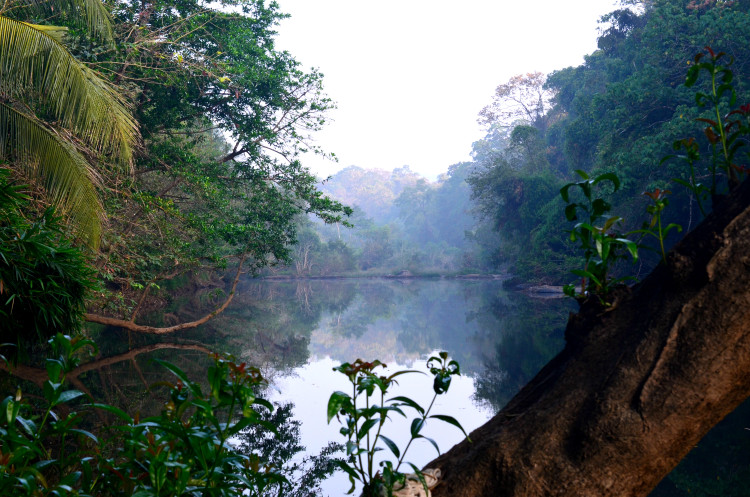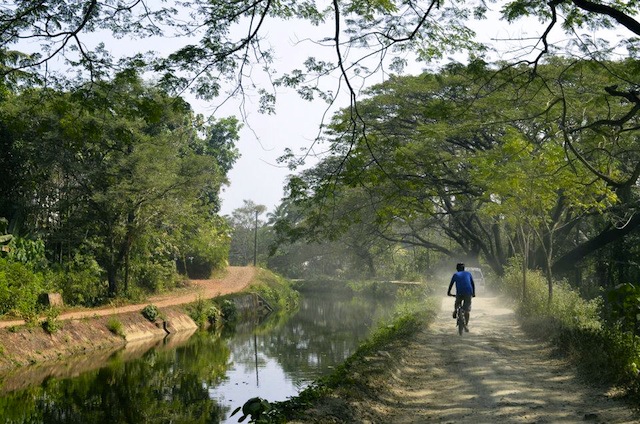
By Jessica Festa
“The people of Kerala don’t like barren land. They like to make use of it,” explains Rattan, my Kalypso Adventures guide. “Most people here have at least two spices growing in their garden. They grow crops and decorate their yards with flowers.”
We’re currently cycling from Kochi to Thattekkad, a 60-kilometer (37-mile) journey that immerses me in the local culture of the canal villages. Sure, a bus would be a quicker option, but this wouldn’t allow me to share a smile with the women washing clothes in the canal, smell the fragrant tapioca and nutmeg growing on the sides of the road, watch teenagers do backflips off bridges into the flowing waters, wave to grown men walking goats and tending to cows, or chat with a group of women burning grass to clean up the roads. And when a young boy of about seven years runs out onto the road carrying a tray of fresh fruit to give me, expecting only a smile and hello in return, I know I’ve made the right decision. These experiences aren’t faded by smudged plexi-glass, and I don’t need them explained to me on a microphone by a bored tour guide. They’re all mine to interpret and cherish.
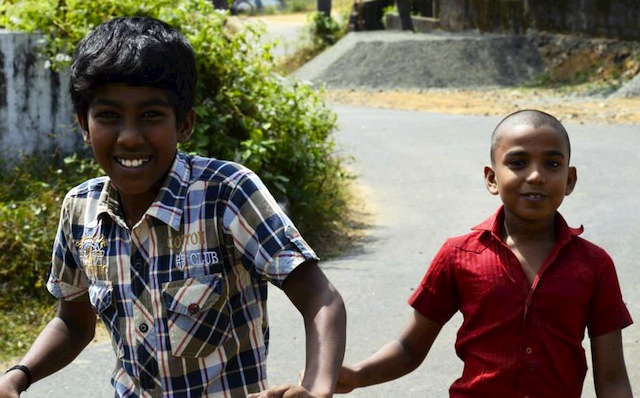
Cultural Immersion In Kerala
My time traveling through Kerala isn’t about doing things the easy way or viewing culture as if it were a movie on a screen; it’s about immersing myself in local culture — discovering it with every single one of my senses — and leaving the smallest carbon footprint possible in the process.
The area I’m cycling resides in the foothills of the Western Ghats, an ancient mountain range older than the Himalayas and one of the most important places in India due to its rich ecology and biodiversity. Along with being home to 24 endemic bird species — some of which include the Malabar Great Hornbill, White Belly Treepie and Nielgerie Fly Catcher — the area boasts the richest bird life on the Indian Peninsula. Moreover, there are a large number of diverse landscapes: hills, highlands, deciduous forest, wetlands and marshlands, to name a few. And you can’t forget the thousands of medicinal plants in the area, which contribute to the Kerala Ayurvedic treatments that are highly sought-after in the state.

The Hornbill Camp
This rich biodiversity is something I get to experience at the endpoint of my cycling trip (at least for Day 1, anyway): the Hornbill Camp. Not only is the camp committed to ecology through serving Indian meals made with local ingredients, using furniture and decor crafted from local woods, and limiting their use of plastic, but they’re also located on the same property as an organic plantation and directly across the river from the Thattekkad Bird Sanctuary, home to more than 260 bird species. The onsite activities I take part in allow me to taste, see, smell, touch and hear Kerala even deeper, like a guided naturalist hike through the plantation and a bird-watching kayaking tour on the River Periyar. By the time I leave, I’ve learned what spice is best for an upset stomach (nutmeg), how locals cure a toothache (with clove) and where the Snakebird gets its name (it has a very long neck).
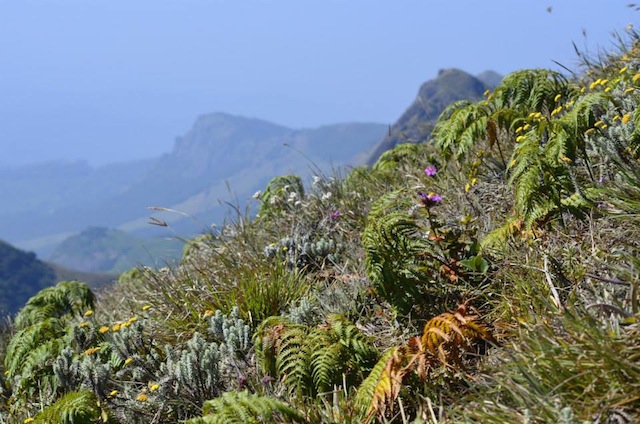
Trekking Through Silent Valley National Park
The stay reminds me why it’s so important to travel in a sustainable manner, and I’m grateful the next day my Kalypso Adventures tour has me scheduled to hike through the Sacred Valley National Park from Munnar — a trek that begins at 1500 meters (4,920 feet) in altitude and goes to 2600 meters (8,528 feet)– instead of taking a narrated car ride (although there is a Nascar-style jeep journey involved to get to the hike’s starting point). In the foothills of the Western Ghats, in a place known for the ability to hear nothing but wildlife in it’s valley, we hike through high-altitude organic tea gardens; sholas (high altitude rain forests that provide water to all the lakes of the state); grassland and pine forest until we reach our campsite at the Rhodo Valley Camp, located at an altitude of 2,200 meters (7,216 feet). It’s true pop-tent camping, warming our hands by the fire and gazing up at a star-filled sky so clear you feel like you’re looking through a telescope.
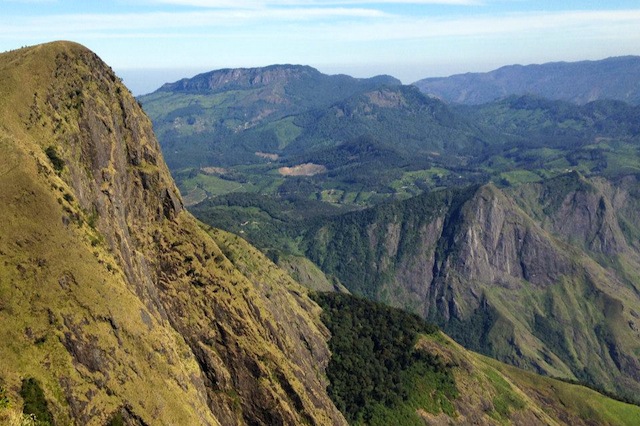
High Peaks And Organic Tea
Trekking through the endless rows of tea, dark green leaves rolling up and down over textured hillside, is just the beginning, as culture meets sustainability once again the next day when we trek from the camp to Suryanelli, ascending the second-highest peak — Meesapulimala — in the Western Ghats. Along the way, I get to visit the world’s highest organic tea garden, Kolukkumalai, at 6,500 to 8,000 feet (1,982 to 2,439 meters). The tea is picked only by women as they have softer fingers less likely to damage the leaves, which are grown without the use of pesticides. The tea trees form perfect terraces in the sides of the mountains, adding contrast to the predominantly green landscape.
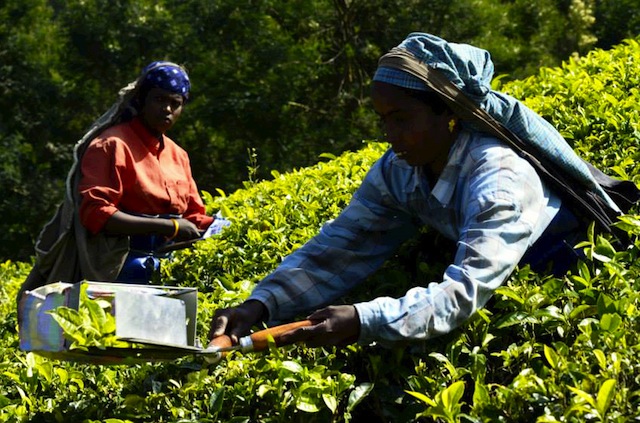
While all the tea trees are grown from the same seeds and appear similar to the naked eye, closer inspection shows the leaves differ in shape, size and shade of green. This combined with the individual production process is what determines whether a tea is black, green, white or oolong. Continuing our descent into the tea estate, we come to a building with a light green room that is the factory, and for 100 Rupees (about $1.60 USD) I’m able to see how the organic tea leafs are dried, withered, centrifuged and made into small, crispy tea bits.
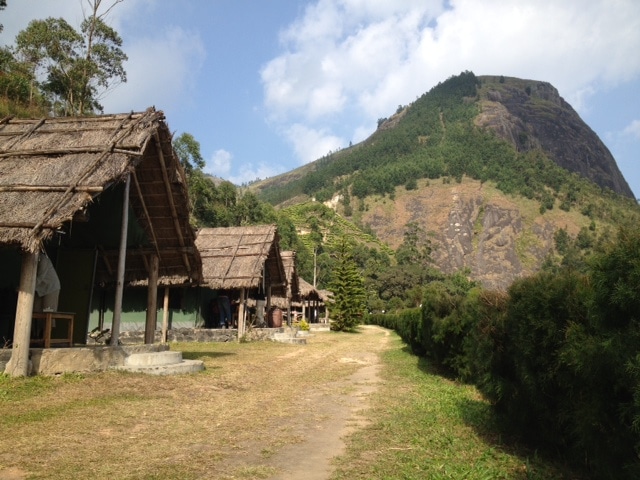
Anaerangal Camp
This is the exact tea I sip that night at my eco-lodge, Anaerangal Camp, which sits at an altitude of 1,600 meters (5,249 feet). From the patio of my simple but comfortable cottage tent, I can see mountains shrouded in mist peeking out over well-manicured bushes, appearing so otherworldly I’m not sure if I’m looking at heaven or Earth. Serenity washes over me, as the sound of honking tuk tuks and speeding buses is replaced with the chirping of birds and occasional rooster crow.
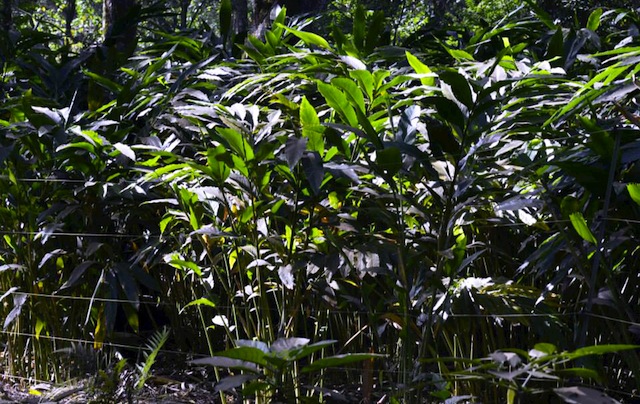
Cardamom Hills
Along with tea, Kerala is also know for its Cardamom Hills, which I experience on a bicycle ride on the 91-kilometer (57-mile) Cardamom Trail. The route is lush with cardamom estates — as well as black pepper, coffee cherries and banana trees — adding a sweet and spicy scent to the air. Cardamom is an important spice in Indian culture, used in cooking and teas and known for its health benefits, such as aiding in arthritis, digestive issues, and tooth and gum infections. As I cycle, cardamom pickers smile and wave, and I get the chance to break open a cardamom seed and smell it up close, the juice leaving its Christmasy aroma on my fingers.
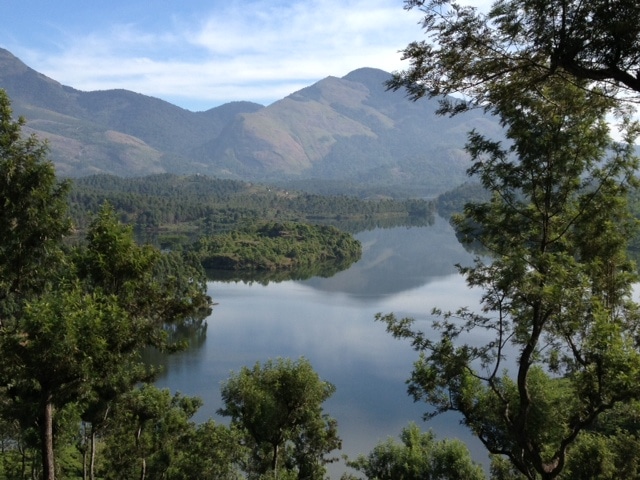
The steep up and down journey is full of spice gardens as well as small towns filled with fruit stands selling dangling bananas, biscuits and sugary sodas, tea shops, and locals waving from the sidewalks in colorful saris and white mundu garments. There’s also time spent cycling around the crystalline Anaerangal Lake, or “lake where the elephants come down,” surrounded by lush hillsides littered with fruit and spice plantations, tea gardens and silver oaks. If you want to spot an Indian elephant, this is a great place to try.

Kumily
My homebase for the evening is a town known for its aromatics: Kumily. On every corner shops offer organic spices, curative herbs and Ayurvedic massage. This is also where Kathakali, a classic Kerala dance form, can be enjoyed. I experience the art form for myself at the Mudra Kathakali Centre, witnessing a performance without words. Originating in the first half of the 17th Century AD and performed only be men, stories are enacted through ornamental costume, elaborate makeup, precise hand gestures, dramatic facial expressions and rapid eye movements that evoke feelings. Traditionally, there are 101 stories and 24 precise hand gestures, each with its own unique meaning. With the purchase of a ticket, viewers are helping this tradition live on.

Ayurvedic Massage
I also get to sample Kerala’s health and wellness culture through a traditional Ayurvedic massage, which incorporates locally sourced healing herbs and spices to cure physical and mental ailments. These are diagnosed using the five senses, and work to balance the body’s life energies (doshas). As mentioned above, Kerala is known for its abundance of curative plants that decorate the landscape, making it a very special place in India to get this type of treatment. During a traditional massage, you’ll undress completely and be rubbed down with curative oils, which work their way into the skin to perform their necessary function.

An Organic Farmstay
My next cycling adventure brings me deeper into this culture, and also works my fitness ability as it’s 102 kilometers (63 miles) away: Dewalokam. An organic farm homestay, the property grows every fruit, vegetable, spice and herb found in Indian cooking and medicine you can think of: turmeric, cinnamon, clove, allspice, cardamom, ginger, mango, jackfruit, starfruit, custard apple, pineapple, long beans, and much much more, all grown in an organic manner without the use of pesticides or chemicals. I learn how allspice can be used in place of almost any spice, and custard apple helps with symptoms of chemotherapy. While cinnamon can help with stomach bugs and cancer prevention, it also adds a sweet yet spicy flavor to food. Then there’s turmeric, which helps with arthritis and pain relief, it’s ginger-like flavor and vibrant yellow color can enhance almost any dish.
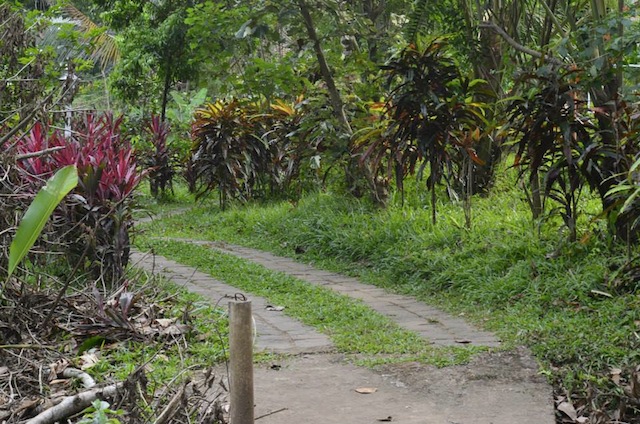
I’m further immersed in Keralan culture through a cooking demonstration, where I watch Chef Sudhish make two tasty dishes: Vegetable Makni and Tandoori Chicken. The Vegetable Makni may look simple on your plate, but it actually contains 10+ spices sourced from the property: clove, star anise, cinnamon, turmeric, chili, cumin, cashew and other aromatics. These spices are sautéed in vegetable oil with onion and garlic and combined with the produce. The Tandoori Chicken is also marinated in a number of property-sourced ingredients, like turmeric, ginger, cumin and even yogurt made from milk from their very own buffalo.
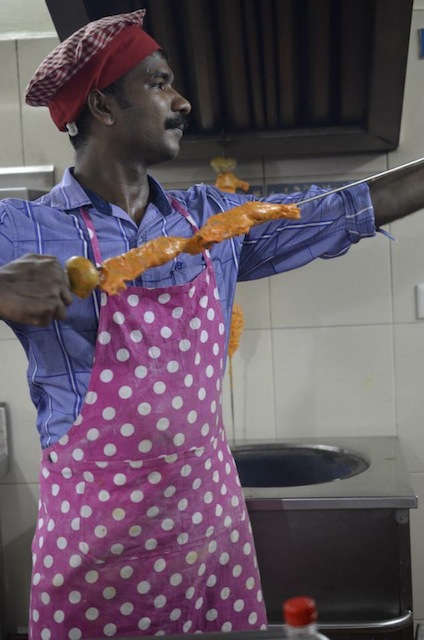
That night’s dinner is served under the stars, which shine bright in this nature-laden area, located away from the lights of the towns and cities. Wine is passed around the table, as our servers set us up with extra buffalo yogurt, grilled buffalo cheese and basamati rice, as well as the main dishes I saw being prepared and mint chutney. I chat with the other guests — a mother and daughter from London, a honeymooning couple from Denmark and a German couple who had visited less than a year ago and loved it so much they returned — asking them about their travels through this naturally fragrant, wildlife-rich state.

We share stories, seeing many of the same places but interpreting them through our own unique lens. That’s what is great about travel. Two people can do or see the same exact thing, but experience it in two completely different ways. For me, my time exploring Kerala in a sustainable fashion has allowed me to interpret the nature-rich destination in such a way I can feel the pulse of the city by bike, interact with locals, smell the sweet fruits and wander medicinal gardens in a truly immersive fashion. In essence, Kerala’s been able to leave its footprint on me, without me leaving mine on it.
This post was originally published on Epicure & Culture. Click here to read it.
ABOUT EPICURE & CULTURE
This article was originally published on Epicure & Culture, an online food, culture and responsible tourism magazine. With a focus on immersive, transformative and ethical experiences, the goal of the publication is to help people explore the world in a positive and life-changing way. Along with visiting their website, you can follow them on Facebook, Twitter and Instagram.
